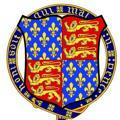
True English History
Channel that supports English Culture and History, which is contrary to liberalism. Posts from an actual impartial perspective, rather then a biased narrative.
Show more383
Subscribers
No data24 hours
No data7 days
No data30 days
- Subscribers
- Post coverage
- ER - engagement ratio
Data loading in progress...
Subscriber growth rate
Data loading in progress...
Repost from THIRD REICH LIBRARY
Third Reich Library would like to wish our beloved Führer of the German Reich a happy one hundred and thirty fourth birthday on this April 20th of 2023 ⚡
1 3 4 !
- Germanic Book ArchiveANGLO-SAXONS RUNES AND ANGLO-SAXONS RUNIC INSCRIPTIONS
Anglo-Saxon runes has its origins in the older Futhark, but enjoys further in Friesland in the current North-West Germany, where Saxons lived 400 years before they immigrants and occupied the British Isles. "Anglo-Saxon runes" is therefore often called the "Anglo-Frisan runes" in thr litteratue. The language of the Anglo-Saxon inscriptions be both Old Frisian and old-English. The oldest inscriptions can be heathen, but most inscriptions that are found, has Christian content, especially those from the British Isles.
Anglo-Saxon runic inscriptions are found along the coast from today Friesland in North-West Germany to the Netherlands and in England and Skottland.
Anglo-Saxon runes, has been in daily use from 400-500's to the 900's, when they gradually went out of brug in line with Viking conquest of England and Skottland, which shows through the many findings of Nordic inscriptions on British Isles from the 900s and later.
The Anglo-Saxon runes, is arguably an successor of the 24-runens older Futhark, when the Anglo-Saxon runic alphabet gradual was expanded with several runes, opposite to what happened in the Nordic countries at the same time. In Scandinavia developed the 24-runers older Futhark to a 16-runers Futhark, while the Anglo-Saxon Fuþorc gradually evolved to consist of 33 runes.
In the Nordic / Germanic runic alphabet is the first 5 runes fuþark, but the first 5 runes in the Anglo-Saxon runic alphabet is fuþorc . Therefore are the the Anglo-Saxon / Anglo-Frisian runic alphabeth primarily called a Fuþorc , after the first 5 runes in the runic alphabet.
The use of runes in England died out around just before the year 1000, and was among others banned by King Knut (1017-1036).
Show all...
1066 A Year to Conquer England 1/3 (Non Politically Correct version)
Norman conquest of England. A non-politically correct version. Enjoy My noble sister from Spain. If you can subscribe to her and by this show your support too, I would appreciate it.
https://www.youtube.com/channel/UCrK8bygiujwcd2Ih56uM9GgAstrid .
Repost from American Resurgeance Channel
THE AMERICAN REVOLUTION - DIRECTORY
PART ONE
https://t.me/TrueAmericanNation/545
https://t.me/TrueAmericanNation/546
https://t.me/TrueAmericanNation/547
https://t.me/TrueAmericanNation/548
PART TWO
https://t.me/TrueAmericanNation/549
https://t.me/TrueAmericanNation/550
https://t.me/TrueAmericanNation/551
https://t.me/TrueAmericanNation/552
https://t.me/TrueAmericanNation/553
PART THREE
https://t.me/TrueAmericanNation/554
PART FOUR
https://t.me/TrueAmericanNation/555
PART FIVE
https://t.me/TrueAmericanNation/556
PART SIX
https://t.me/TrueAmericanNation/557
SOURCES:
REFORGING AMERICA
THE ROYALIST REVOLUTION
ANTI-MASONIC ALMANACS
